Everything you need to know before traveling to Denmark for a live football experience.
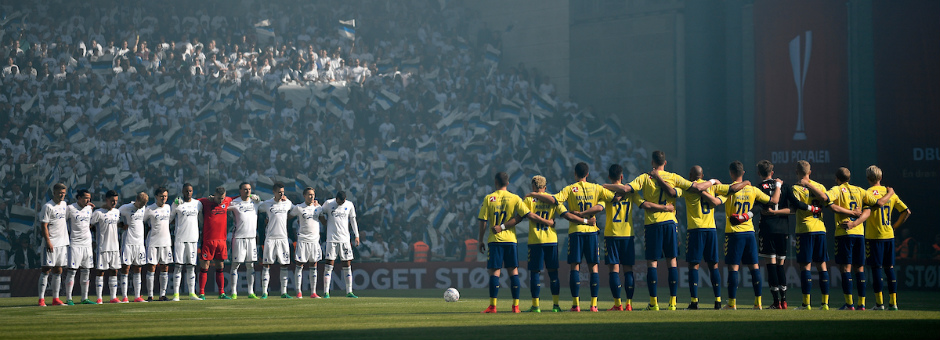

|
Danish Superliga clubs 2020/2021
|
|||||
|---|---|---|---|---|---|
| Club | Stadium capacity | Avg. attendance 2019/2020** | Championships (latest) | Cup Winners (latest) | Groundhopper App check-ins* |
| AC Horsens | 10,400 | 1,932 | 0 | 0 | 1,592 |
| AGF | 20,032 | 8,863 | 5 (1986) | 9 (1996) | 2,315 |
| AaB | 14,135 | 4,353 | 4 (2014) | 3 (2014) | 1,604 |
| Brøndby IF | 28,000 | 11,255 | 10 (2005) | 7 (2018) | 4,558 |
| FC København | 38,065 | 12,500 | 13 (2019) | 8 (2017) | 7,200 |
| FC Midtjylland (Champions) | 11,800 | 6,487 | 3 (2020) | 1 (2019) | 2,064 |
| FC Nordsjælland | 10,300 | 1,955 | 1 (2012) | 2 (2011) | 1,809 |
| Lyngby BK | 10,100 | 3,313 | 2 (1992) | 3 (1990) | 1,459 |
| OB | 15,790 | 5,666 | 3 (1989) | 5 (2007) | 2,292 |
| Randers FC | 10,300 | 3,248 | 0 | 1 (2006) | 1,383 |
| SønderjyskE (Cup Winners) | 10,000 | 3,972 | 0 | 1 (2020) | 1,574 |
| Vejle Boldklub (Promoted) | 10,418 | 2,100 | 5 (1984) | 6 (1981) | 1,129 |
* Number of users who checked into the stadium, using the Futbology app (per September 30th, 2020).
** The attendance for the 2019/2020 season is highly affected by closed stadiums due to Covid19.
Video credits: Ultras World
The first Copenhagen Derby was played in September 1992 and ended with a 1-1 draw, just a few months after FC København was founded. In the years before FC København was founded, Brøndby IF had a rivalry with B1903, who, at the time, was the stronger of the two founding clubs (along with KB) of FC København.
From the beginning, it was clear that a new derby and a strong rivalry was born in the Danish capital, with both clubs competing to be the dominant force in Danish football. Through more than 25 years, the derby has now developed into the biggest game in the Danish season, and the two sets of fans have developed their own fierce competition to be the dominant force of the capital. The tensions rise high in the week and days before the derby, as both players and fans prepare themselves for battle.
A result of the fierce competition between the two sets of supporters is the amazing choreographies displayed in the stands during each derby which is often reported in the media, even beyond the Danish borders.
Brøndby Stadium is located in the western suburbs of Copenhagen in a large area called ‘Vestegnen’ which is traditionally a working-class area, whereas FC København is played at Parken Stadium, located closer to the centre of Copenhagen, in the area of ‘Østerbro’, slightly north of the city centre. The distance between the two stadiums is 13 kilometres across the capital.
The amazing spectacular of the derby, both on and off the pitch, has attracted many football travellers and groundhoppers to the Danish capital.

The Danish Superliga matches are usually played with one match Friday evening, sometimes a match on Saturday evening, most matches on Sunday, and one match Monday evening. Kick off times are planned 4-6 weeks ahead of time.
The full Superliga fixture list for 2020/2021 can be found here: superliga.dk/fixtures.
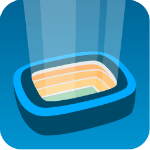
Futbology (formerly known as the Groundhopper App) is great help for you to find fixtures when in Denmark (or anywhere in Europe). The app contains a lot of useful features for any football traveller and groundhopper. One is the "Nearby fixtures" allowing you to find matches close to your current position.
Futbology is available in the App Store for iOS and on Google Play for Android.
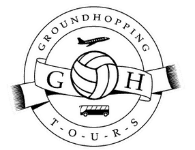
If you need help planning your trip to Danish matches, the experienced groundhopper Nicolai Bryde Nielsen offers free advice and help to anyone who contacts him.
You can contact Nicolai Bryde Nielsen through one of his two websites: groundhopping.dk or groundhoppingtours.dk.

The Facebook page Groundhopping.dk (+500 members) offers the possibility to discuss football travel and ask for advice.
The magazine Football Weekends offers travel advice and inspiration.
The Outside Write blog and podcast about football travel, culture, and history offers insights into the world of fan culture.

Denmark is well connected by trains and busses, making it fairly easy to get around. As Denmark is a small country, travel times can be short. Getting from one end to the other can be done within a few hours.
Plan your trip (trains and busses) using the travel planner here: rejseplanen.dk (English and German versions available).

Copenhagen Airport is by far the airport with the most international connections and is a major hub in Scandinavia. The other smaller airports have international connections to some of the main European hubs.
English guides to the airports: Copenhagen Airport, Billund Airport, Aalborg Airport, Odense Airport and Aarhus Airport.



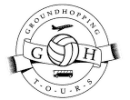

Most football travelers will find the cost of tickets of Danish matches fairly low compared to the rest of Europe. Some clubs have got fixed ticket prices throughout the season, and some change the prices depending of the opponent and stage of the season.
Ticket prices in Denmark range from DKK 80-250 (€11-34 / £10-30) for most games and go a bit higher for important and decisive matches near the end of the season and the Copenhagen Derby, but don’t expect ticket prices higher than around DKK 400 (€55 / £48).
Danish matches are rarely sold out and tickets can be bought online 2-4 weeks before the matches (find links to purchase tickets in the sections for each club in this guide).
Most stadiums in Denmark have got a fairly high standard of service and general comfort, as many stadiums have either been modernised or have been newly build within the last 10-20 years. Year of last major modernisation or year built:
Lyngby BK: 2016
SønderjyskE: 2014
Randers FC: 2013
AC Horsens: 2009
FC København: 2009
Velje Blodklub: 2008
Brøndby IF: 2008
FC Midtjylland: 2004
AaB: 2002
AGF: 2001
FC Nordsjælland: 1999
OB: 1997
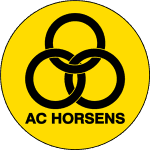
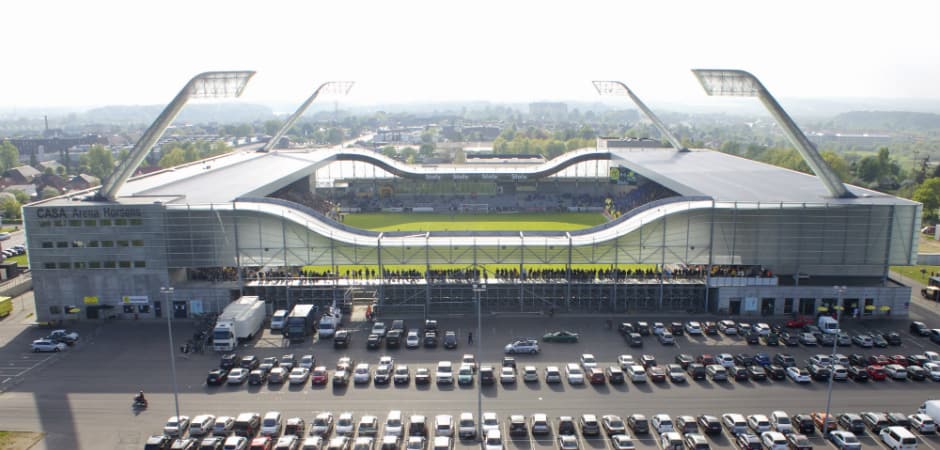
AC Horsens was founded in 1994 after smaller local clubs joined forces to create a bigger and more powerful club. The official name of the club is Alliance Club Horsens and it is located in the city of Horsens, which has around 58,000 inhabitants in the eastern part of Jutland.
The 2011-2012 season was the best season so far for AC Horsens. The club finished fourth in the league and reached the Danish Cup final, which they lost to FC København by a score of 1-0. Reaching the final, even though losing, qualified the team for the Europa League. AC Horsens entered the third qualifying round, beating the Swedish side Elfsborg, but lost to Sporting CP of Lisbon in the play-off round by an aggregated score of 6-1.
Horsens is located on one of the main train lines in Denmark, making the city easily accessible. The closest international airport is Billund Airport, a 45-minute drive from Horsens by car. Billund Airport has no direct train or bus connection with Horsens, but you can reach the nearby city of Vejle by bus (30 minute ride) and change to a train at Vejle Station, making your way to Horsens with an extra 15 minute train ride.
Alternatively, flying to Copenhagen Airport is an option and then from Copenhagen Central Station the direct train to Horsens Station is 2 hours and 20 minutes.
From Horsens city centre to the stadium is a short walk north (2 kilometres).
Video credits: patrick240896
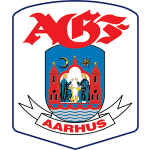
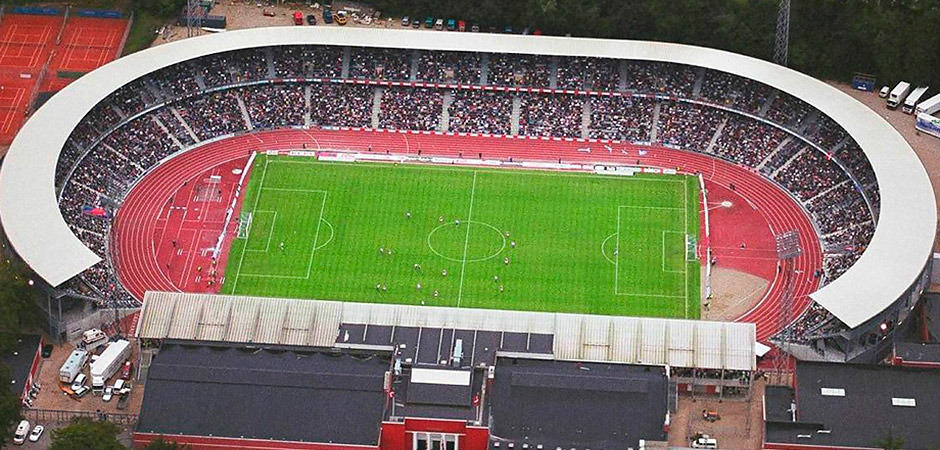
AGF or ‘Aarhus Gymnastikforening af 1880’, which is the official name of the club, is one of Denmark’s oldest clubs. The club does not only include football but also a lot of other sports. In fact, the football department of the club started in 1902, 22 years later than the club itself.
AGF is located in the second largest city in Denmark, Aarhus, which has 273,000 people. Historically, AGF is one of Denmark’s most successful clubs, winning five championships (the latest in 1986) and nine cup finals (the latest in 1996). With more than 22 years without any trophies, AGF is the ‘sleeping giant’ of Danish football, with an unfulfilled potential to dominate and with a large city to back them up.
Aarhus has its own international (but small) airport, located 40 kilometres north of the city. The airport mainly has Scandinavian connections with Stockholm, Oslo, and Gothenburg, but also serves direct flights from London and Munich. From Aarhus Airport to Aarhus city centre is a short 45-minute shuttle bus ride.
Alternatively, a direct train connection from Copenhagen Central Station to Aarhus Main Station takes 2 hours and 50 minutes.
Ceres Park is located four kilometres south of the city centre in the Marselisborg Forests. The stadium can be reached by foot or local busses.
Video credits: SamletForAarhus

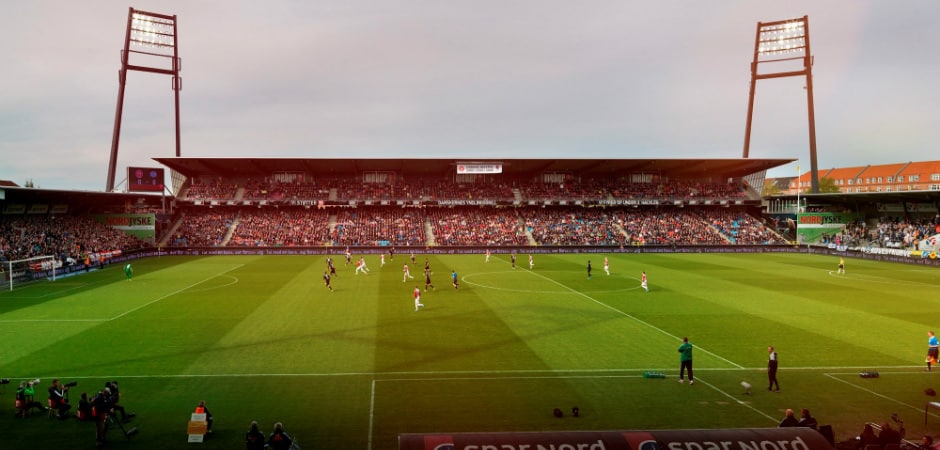
‘Aalborg Boldspilklub’ is the official name of AaB, one of the oldest football clubs in Denmark, founded in 1885 in the city of Aalborg. Aalborg is the fourth biggest city in Denmark with 137,000 inhabitants which gives the club a strong fanbase.
AaB won the latest of four championships in 2014, a great year for AaB in which they also won the cup final, securing The Double for the first time in the history of the club. Previous AaB teams won the Danish champions in 1995, 1999, and 2008, and the Danish cup in 1966 and 1970.
Two times AaB has made it to the Champions League group stage in 1995 and 2008, one time in the group stage of the UEFA Cup in 2007.
Getting to the city centre from Aalborg Airport is easy, as it is located only 7 kilometres away. Local busses departure often with a short trip of 20-25 mins to reach the city centre. Aalborg Airport serves flights from Copenhagen, Oslo, London, and Amsterdam. In the summer it also serves various destinations in southern Europe.
The famous street ‘Jomfru Ane Gade’ is located in the centre of Aalborg. The main nightlife of Aalborg is found here in the form of numerous restaurants and bars.
The stadium is around two kilometres west of the city centre, with a short walk of 20 minutes to get there. Local busses also serve the surrounding area of the stadium.
Video credits: VesttribunenTV
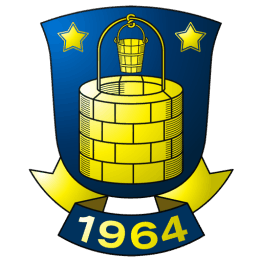
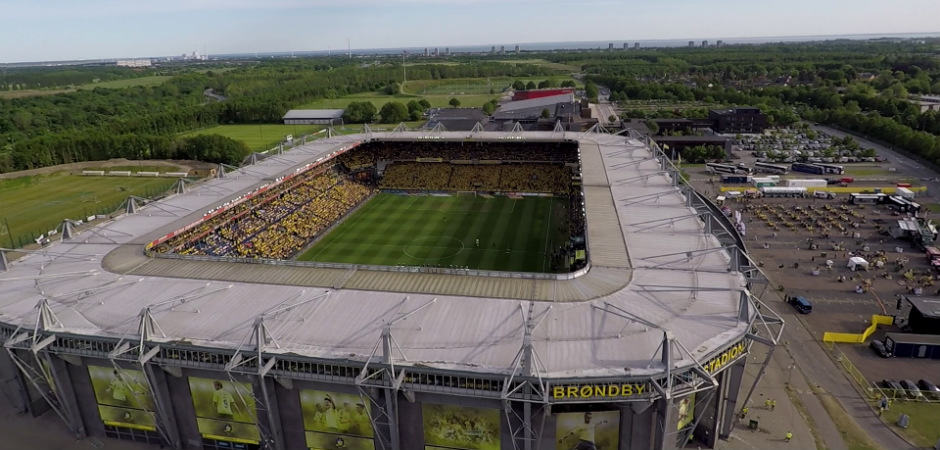
The full name of the club is Brøndbyernes IF, and it was founded in 1964 as a result of two small local clubs joining forces.
Brøndby IF has won the Danish championship 10 times, the last time in 2005 with all-time legend Michael Laudrup as coach. In 2018, Brøndby IF won the Cup final for the seventh time, after 12 years without a trophy.
Their best European result was in 1991, when the club reached the semi-final of the UEFA Cup, only losing with a last-minute goal to AS Roma at Stadio Olimpico.
Brøndby IF has once made it to the group stage of the Champions League, in 1998. The group consisted of FC Barcelona, Bayern München, and Manchester United.
Copenhagen Airport is one of the main hubs in Scandinavia and has direct connections to most of Europe. From the airport, trains and the metro have direct lines to the centre of Copenhagen and take about 20-25 minutes.
Brøndby Stadium is located in the western suburbs of Copenhagen, about 11 kilometres from the city centre. The stadium can be reached by two S-train lines from the central stations in Copenhagen or the B-line to Glostrup or Brøndbyøster in about 15 minutes. It is about a 2.5 kilometre walk to the stadium from both stations. Local busses are also available.
Alternatively, the A- or E-line reaches Brøndby Strand in 17 minutes, which is a walk of 3.4 kilometres to Brøndby Stadium. Local busses are also available from Brøndby Strand station.
Video credits: 3point.dk
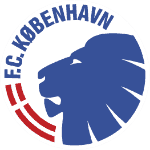
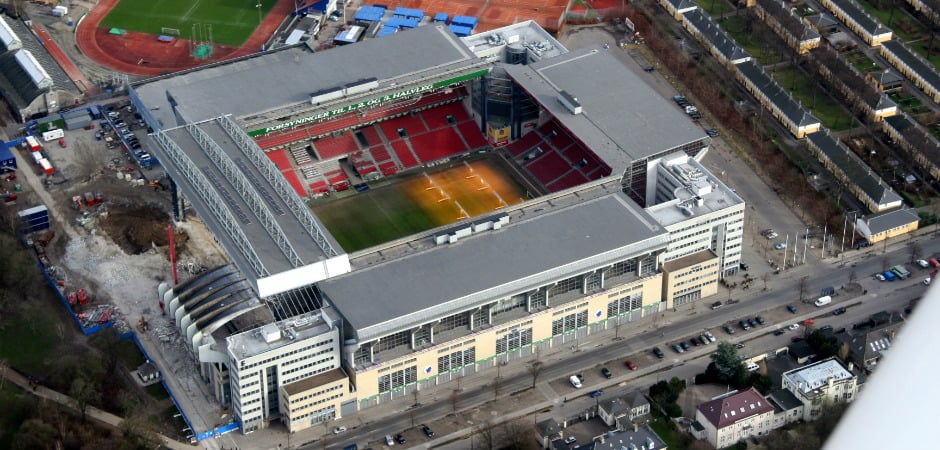
FC København was founded in 1992, as a result of two clubs, KB (the oldest football club in Denmark) and B1903, joining forces. The young clubs where soon successful and won the Danish championship in their first season (1992/1993).
Since then, FC København has been of the most successful Danish clubs, winning the championship 13 times (the latest in 2019) and the cup 8 times (the latest in 2017).
The best result in the Champions League for FC København was in the 2010/2011 season, when the club finished second in the group stage and reached the round of 16 against Chelsea. In the aggregated score, FC København lost 2-0 to Chelsea. The clubs also hold the Danish record of most times reaching the group stage in the Champions League and the Europa League.
Copenhagen Airport is a major hub in Scandinavia and very well connected to the rest of Europe and some overseas destinations. From the airport, the city centre of Copenhagen can be reached directly with trains or the metro in around 20-25 minutes. The airport has its own train station and metro station.
Copenhagen is a modern European city with 1.3 million inhabitants in the metropolitan area. Getting around the city is easy with a lot of metro lines, s-train lines, and fast bus connections.
The stadium of FC København, Telia Parken, is located 3.5 kilometres north of the city centre in an area called ‘Østerbro’. From Copenhagen Central Station, the s-train reaches the Svanemøllen, Nordhavn, and Østerport stations within 10-12 minutes: all within a short walking distance of Telia Parken.
Video credits: FC København
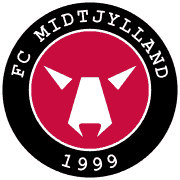
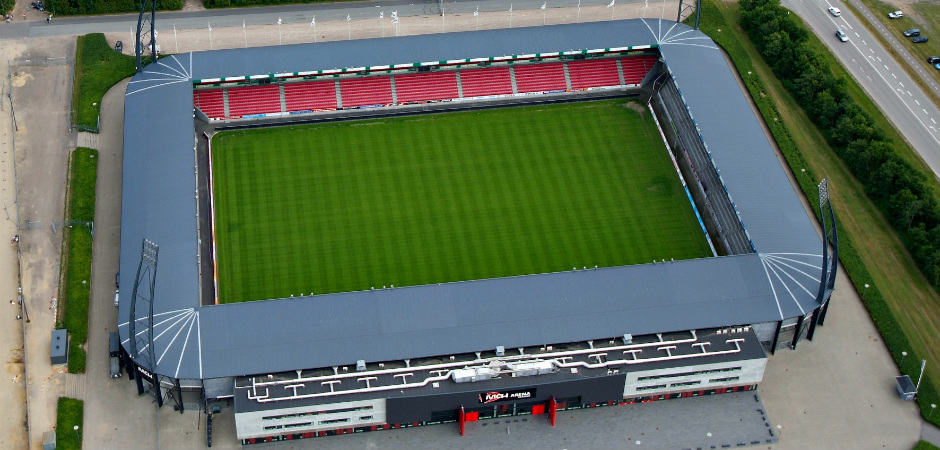
FC Midtjylland was founded in 1999 as a result of two minor clubs getting together to create a greater force to compete on the national level, as many other Danish football clubs have done. FC Midtjylland is made up of the former local clubs Herning Fremad and Ikast FS.
FC Midtjylland played their first season in the second best Danish division, which they won and were promoted to the Superliga for their second season. In 2015, the club won the first of two Danish championships (so far). Five appearances in the Danish Cup final with one victory (2019) for FC Midtjylland.
Their best European result for the club was in in 2015-2016 season, when the club reached the group stage of the Europa League, finished second after Italian side Napoli, and faced Manchester United in the round of 32, losing 6-3 in aggregated score.
The city of Herning is located a 50 minute car drive from Billund Airport. Using the GoShuttle busses, it’s possible to reach Herning within one hour directly from Billund Airport.
Alternatively, from Copenhagen Central Station the journey can be done in around three hours with one change of train in Fredericia.
Herning is a city of 45,000 inhabitants in the central part of Jutland, making it the 13th largest city in Denmark.
The stadium (MCH Arena) is located 3.5 kilometres south of Herning city centre and the train station. By foot, the stadium can be reached in 45 minutes, but local busses are also available from the city centre.
Video credits: Kent Tornøe
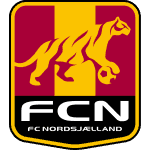
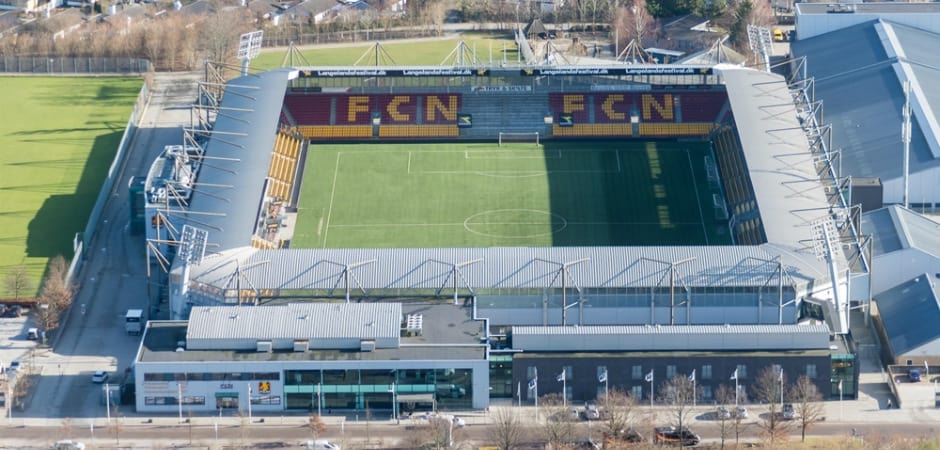
The club was officially founded in 2003, as the former club Farum Boldklub changed their name to FC Nordsjælland. The original club was also very young, established in1992. FC Nordsjælland is well known for developing young talent and, throughout the years, many rising stars started their careers here.
FC Nordsjælland has won the Danish championship once, in 2012, and the Danish Cup two times, in 2010 and 2011. Both Cup finals were won against FC Midtjylland.
Their best European result was in the 2012/2013 season, when FC Nordsjælland reached the group stage of the Champions League, playing Chelsea, Juventus, and Shakhtar Donetsk. Their best result was a 1-1 draw against Juventus at home.
The city of Farum is located 20 kilometres north of Copenhagen and inhabits 20,000 people. When traveling to Farum, it’s recommended to stay in Copenhagen, as the capital offers many more options for accommodation than the small town of Farum. Using public transportation, the city and be reached by s-train (line A) from all the major stations in central Copenhagen within 40 minutes.
By car from Copenhagen Airport, the drive is around 45 minutes to arrive in Farum. With public transport, simply change from the metro to s-train at Nørreport station and, from there, the s-train will arrive directly in Farum.
The stadium Right to Dream Park is located 1.6 kilometres from the train station in Farum and can be reached by a 20 minute walk. Local busses are also available.
Video credits: FC Nordsjælland
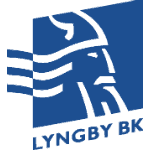
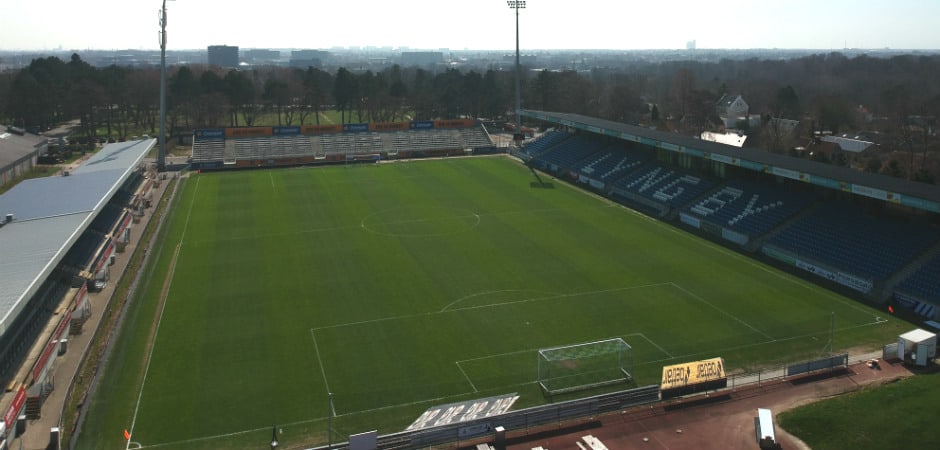
Lyngby Boldklub is one of the oldest football clubs in Denmark and is well know for its well performing youth academy. The recent years has been troublesome for Lyngby BK with a lot of financial problems, going up and down between the Superliga and 1. Division (Danish second tier).
Lyngby has won the Danish championship two times, with the last championship dating back to 1992. The cup final has been reached five times, with three victories (the last in 1990).
A number of times Lyngby BK has played in the European tournaments, best results was reaching the second round of the European Cup in 1984, and then loosing 1-2 to Sparta Prague and the year after in 1985 reaching the second round of the UEFA Cup Winners’ Cup, loosing 3–5 to Red Star Belgrade.
The city of Lyngby is located about 12 kilometres from the center of Copenhagen in the northern suburbs and inhabits 55,000 people. If traveling to Lyngby for at games, it can be recommended to stay in the center of Copenhagen. Using public transportation, Lyngby can be reached by s-train from the major stations in central Copenhagen within around 20 minutes.
From Copenhagen Airport to Lyngby by car is 35 minutes drive. Arriving with the public transport is fairly easy, from the Airport get on the metro to Nørreport station and, from there, change to the s-train directly to Lyngby.
Lyngby Stadium is located 1.7 kilometres from Lyngby train station and can be reached by a 25 minute walk. Local busses also arrive close to the stadium.
Video credits: Lyngby Fans
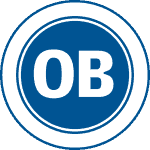
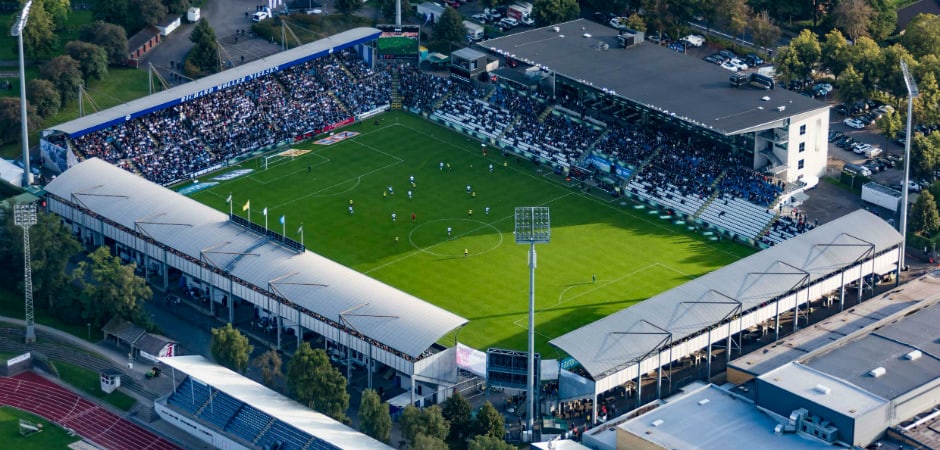
The full name of the club is Odense Boldklub but is usually referred to simply as OB. The club was founded in 1887, making it one of the oldest football clubs in Denmark. OB is the only club in the Danish Superliga located in the island of Funen (Fyn in Danish).
OB has won the Danish championship three times, with the latest in 1989, and the Cup final five times, the latest in 2007 against FC København with a 2-1 victory.
The most famous European result is from the 1994/1995 season when OB reach the quarterfinals in the UEFA Cup, after eliminating Real Madrid with a 2-0 win at Santiago Bernabéu after a 2-3 defeat in the first leg at home. In the quarterfinal, OB lost to Italian side Parma. OB reached the group stage of the UEFA Cup/Europa League three times: in 2006, 2010, and 2011.
Odense is the 3th largest city in Denmark, with 180,000 inhabitants, and is located in the middle of Denmark as the capital of the island Funen. Odense is well connected with trains to the rest of the major cities in Denmark.
Odense has a small airport with few international destinations which is located 12 kilometres north of the city centre and served by local busses. Arriving from Copenhagen is fast, as directs trains from Copenhagen Central Station arrive in 1 hour and 15 minutes to the main station of Odense.
The stadium, Nature Energy Park, is located 2.9 kilometres west of the city centre and can be reached by foot in 30 minutes or by local busses in 15 minutes.
Video credits: OdenseFilmTA

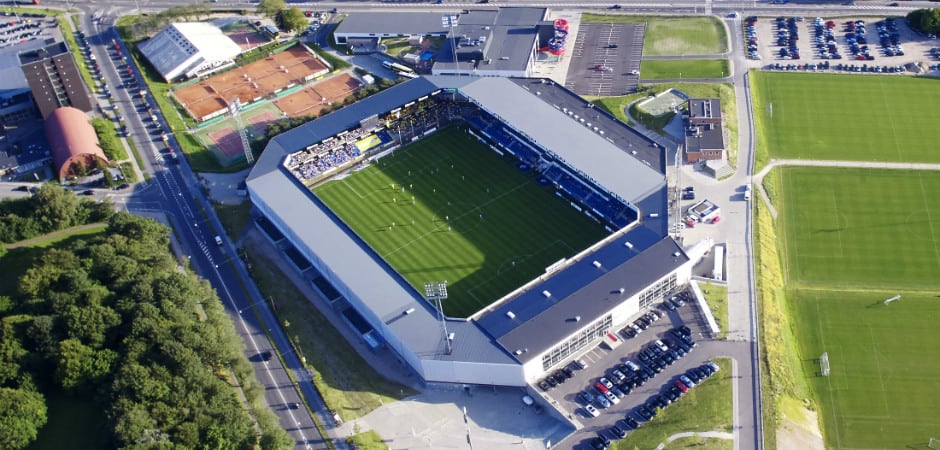
Randers Football Club was founded in 2003 as six local clubs joined up to create one strong club for the city of Randers. The clubs started the two first seasons in the Danish second division and played their first season in the Superliga in the 2004/2005 season.
Their two best results was finished third in the Danish league in the 2012/2013 season and winning the Danish Cup final in 2006 defeating Esbjerg Fb 1-0.
The club’s best European results were reaching the 3rd qualifying round of the UEFA Cup/Europa League three times, in 2006, 2009, and 2010. They were eliminated by strong international sides: Fenerbahce, Hamburger SV, and FC Lausanne.
Randers is located around 50 kilometres from Aarhus Airport which is fairly small with only a few international connections, 90 kilometres from the larger Aalborg Airport, and 125 kilometres from Billund Airport.
Randers can be reached by direct train from Copenhagen in 4 hours.
The city of Randers is the 6th largest in Denmark, with 62,000 inhabitants, and is in the region of Jutland called ‘Kronjylland’ in Danish.
The home of Randers FC, BioNutria Park, is located 2.1 kilometres west of the city centre and can be reached by foot in 25-30 minutes. Some local busses also serve the stadium.
Video credits: NORDTRIBUNEN
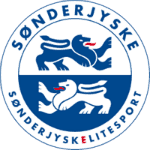
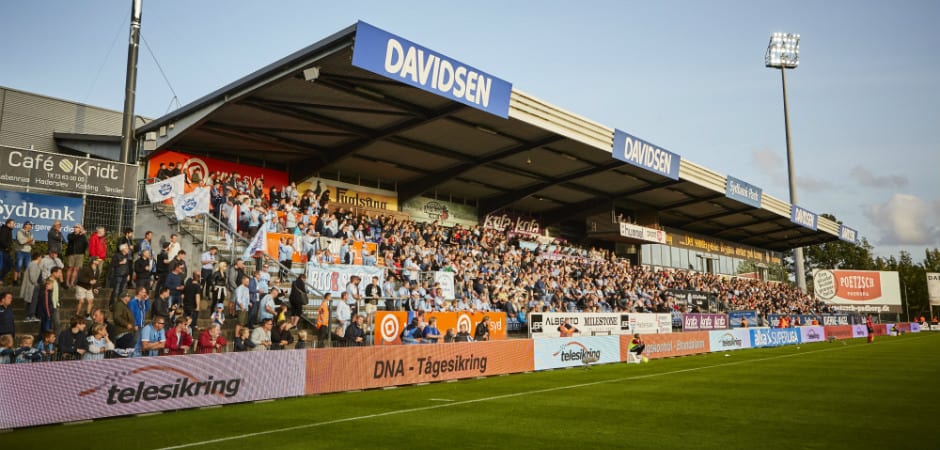
The full name of the club is Sønderjysk Elitesport Fodbold, but usually the shortened version SønderjyskE is used. The club was founded in 2004, after the club Haderslev FK changed its name. SønderjyskE is located in the city of Haderslev.
The best domestic result of SønderjyskE was finishing second in 2016 and two times reaching the semi-final of the Danish Cup in 2012 and 2015.
SønderjyskE has played in the qualifying rounds for the Europa League once, in 2016, reaching the play-off round before losing in an aggregate score of 3-2 to the Czech side Sparta Prague, after eliminating Norwegian side Strømsgodset and Polish side Zagłębie in the two first rounds of the qualifying stage.
The city Haderslev has got 22,000 inhabitants and is in the southern part of Jutland. The city is the 30th largest city in Denmark.
Arriving in Haderslev is a bit more complicated than to the other 13 Superliga clubs, as it is the only city not served by trains. Arriving overland requires a change from train to a local bus in the city of Kolding, which is very well connected with trains from Copenhagen and direct connections to Billund Airport via bus.
The bus from Kolding arrives in Haderslev with a travel time of 35 minutes. From Copenhagen Central Station to Kolding Station the journey can be done by direct train in around two hours.
Video credits: SønderjyskE Fodbold Support - BluE Section

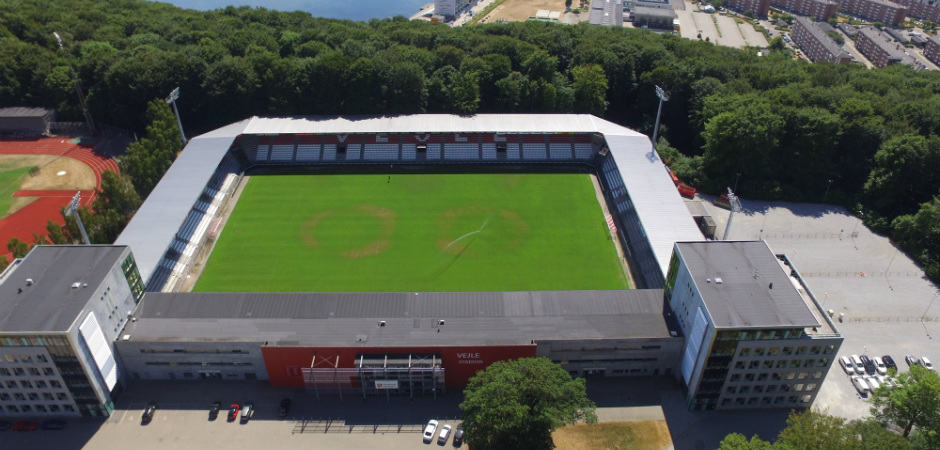
Vejle Boldklub is one of the oldest football clubs in Denmark: it was founded in 1891 as a cricket club and in 1902 as a football club. From 1924 until 2007, Vejle Boldklub played their home games in the old Vejle Stadium and moved in 2008 to a new modern stadium with the same name.
The 1950s and 1970s were the golden age of Vejle Boldklub. They won the Danish championship five times (1958, 1971, 1972, 1978, and 1984) and the Cup final six times (1958, 1959, 1972, 1975, 1977, and 1981). Since then the club has struggled to gain some of their lost power.
Their best European result was in 1978 when the club reached the quarter final in the Cup Winners’ Cup, losing to the Dutch side FC Twente 7-0 in aggregated score.
Vejle is a city of 56,000 inhabitants (9th biggest in Denmark) and the city has a central geographical position in the country. Billund Airport is only 30 kilometres away with a direct bus connection.
Vejle is also served by the main train connections to all major cities in Denmark. From Copenhagen Central Station, the journey can be done in around two hours by train directly to Vejle Station.
The stadium of Vejle is in the northern part of the city, 1.9 kilometres from the train station. It can be reached by foot in around 25 minutes (uphill) and by local busses. The stadium is beautifully situated in a small forest.
Video credits: RedArmyVejle
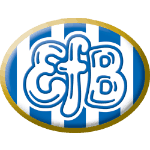
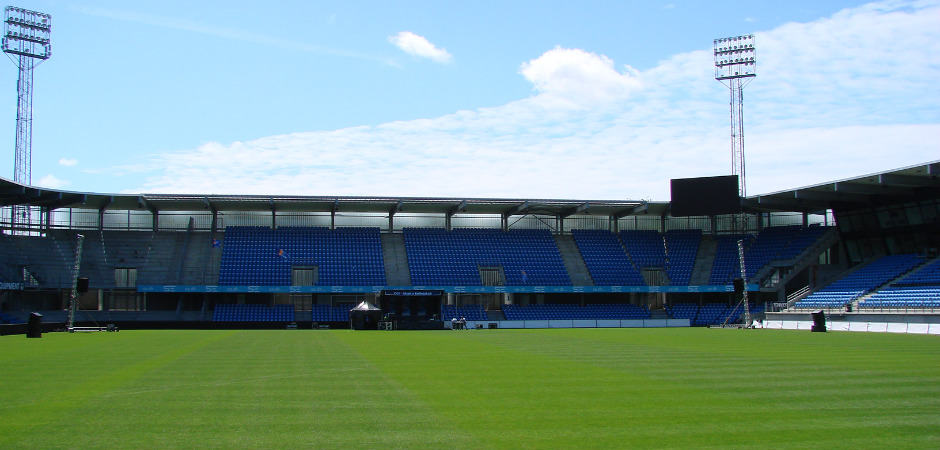
Esbjerg fB was founded in 1924 with the full name ‘Esbjerg forenede Boldklubber’, as two smaller local clubs wanted to create one strong team for the city of Esbjerg. The city is the fifth biggest in Denmark, with 72,000 inhabitants, and has one of the largest harbours in the country.
Esbjerg fB has won the Danish league five times, the latest in 1979, and the Cup final three times. Their last trophy was the Cup in 2013.
Their best European performances was in the 2013-2014 season when Esbjerg qualified for the group stage of the Europa League after eliminating the French side Saint-Étienne in the play-off. Esbjerg finished second in group C and was drew Fiorentina from Italy in the round of 32. Esbjerg lost 2-4 on aggregates.
Esbjerg is well connected with trains to the major Danish cities and with two direct bus lines from Billund Airport (travel time around 1 hour and 15 minutes).
Alternatively, the journey from Copenhagen Central Station is around three hours with a direct train to Esbjerg Station.
Blue Water Arena is in the northern part of Esbjerg, about a 30 minute walk (2.5 kilometres) from the city centre and train station. Local busses are also available to the stadium.
Video credits: NordvestkurveTV
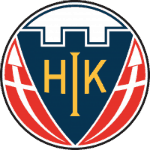
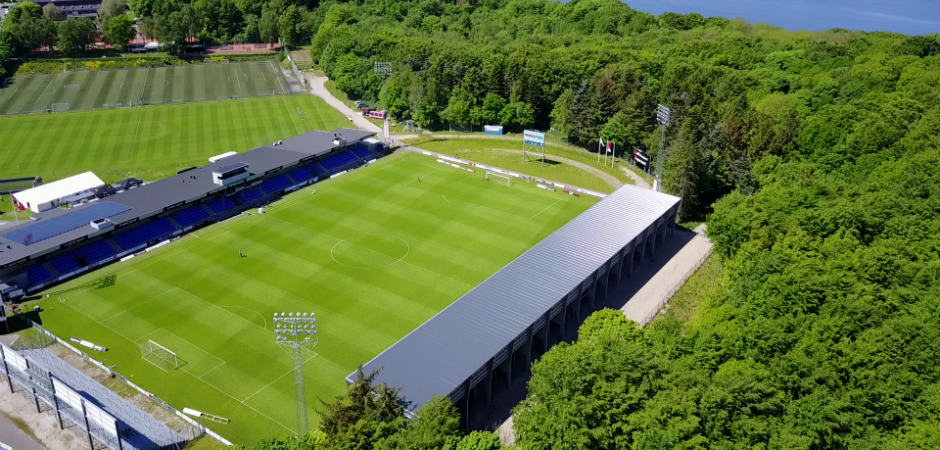
‘Hobro Idræts Klub’ was founded in 1913 and is located in the northern part of Jutland in the city of Hobro. Home games are played in the small stadium, called DS Arena, with a capacity of 10,700 spectators.
Until the 2014/2015 season, Hobro IK had never played in the Danish Superliga, but only four years after being promoted to the ‘1. division’ (the second tier in Denmark), Hobro was promoted to the Superliga for the 2014/2015 season.
In their first Superliga season, Hobro surprised everyone by first beating the two big teams, Brøndby 2-0 at home and FC København 3-0 away in Copenhagen.
Hobro is situated 50 kilometres south of Aalborg in the northern part of Jutland. The city has only 12,000 inhabitants, making it the smallest city with a Superliga club.
Hobro is connected directly to the major Danish cities, with a station on the main train lines through the country. Arriving from Aalborg by train in only 50 minutes and from Aarhus in 1 hour and 15 minutes.
From Copenhagen the direct train makes the journey to Hobro in 4 hours and 30 minutes.
DS Arena is located 3.0 kilometres southeast from the train station and can be reached by foot in 45 minutes and with the local bus in around 25 minutes.
Video credits: TM-Film Produktion
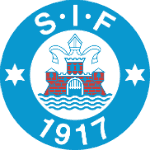
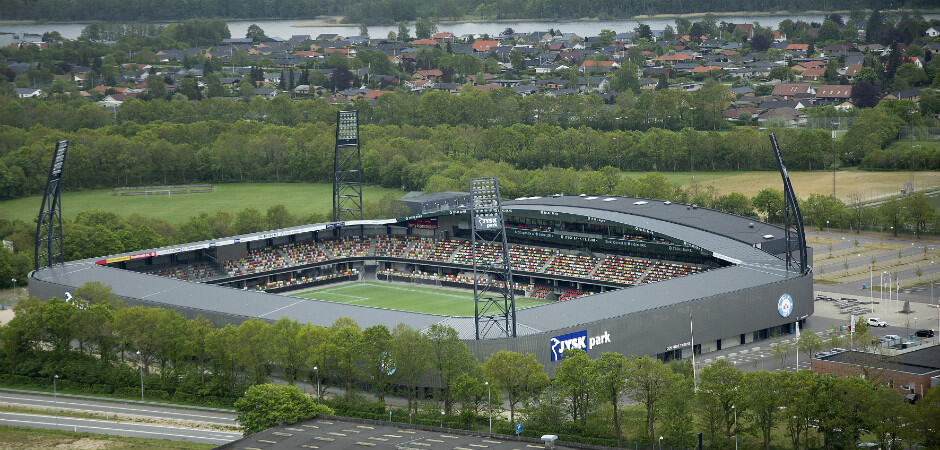
Silkeborg IF was founded in 1917 and therefore celebrated its 100 years in 2017, which makes it one of the oldest in Denmark. In 2017 the club moved to the new stadium Jysk Park with a capacity of 10,000 spectators. The new stadium project was completed as a collaboration between the club and the city council.
The greatest result of the club was winning the Danish championship in 1994 and winning the cup final in 2001. Since then the results has been less prominent and the club has been relegated to 1. Division a few times.
The best european result for Silkeborg IF was reaching the second qualifying round of the UEFA Cup in 1998 and then loosing 0-3 to AS Roma.
The city of Silkeborg is the 15th largest in Denmark, with 43,000 inhabitants and is located around 70 kilometres north of Billund Airport and 45 kilometres west of Aarhus. The city is known for the beautiful lakes surrounding the area.
Silkeborg can be reached by train from Aarhus in 50 minutes and from Copenhagen in 4 hours.
The new home of Silkeborg IF, Jysk Park, is located 3.5 kilometres northeast of the city centre and can be reached by foot in 25-30 minutes. Some local busses also serve the stadium.
Video credits: Stoltheden Silkeborg
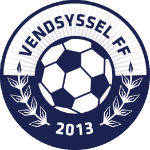
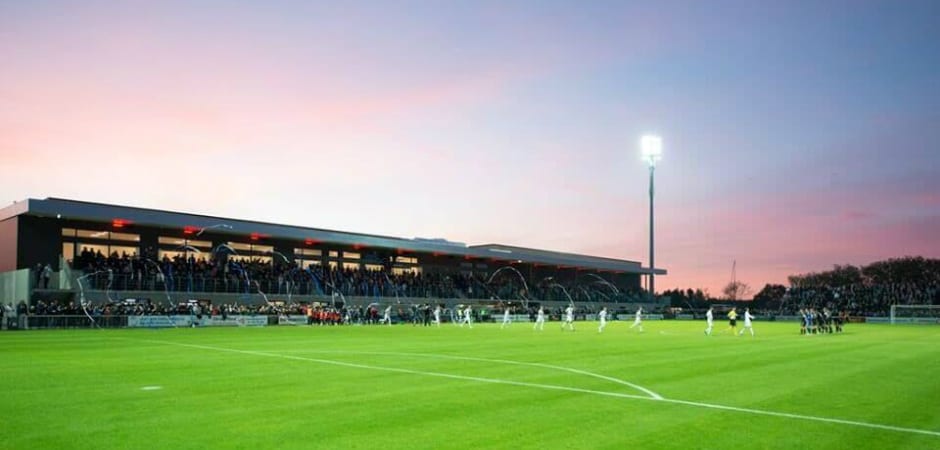
Vendsyssel Forenede Fodboldklubber is the full name of the club and has taken its name from the surrounding region, called Vendsyssel. The club was founded in 2013, making it the youngest in the Superliga. It was formerly known first as Hjørring IF (from 1919) and then FC Hjørring (from 2006).
The 2018/2019 season was the first and so far only season for the club in the Danish Superliga, playing their home games at Nord Energi Arena in the city of Hjørring.
Hjørring is the most northern of all the cities in the Superliga, situated 45 kilometres north of Aalborg and has 26.000 inhabitants.
Hjørring is served by direct train connections from Aalborg (40 minutes) and Copenhagen (around 6 hours) with one change in Aalborg.
Nord Energi Arena is located less than 1 kilometre from the train station, making it very accessible: just a 10 minute walk.
Video credits: Vendsyssel FF Support